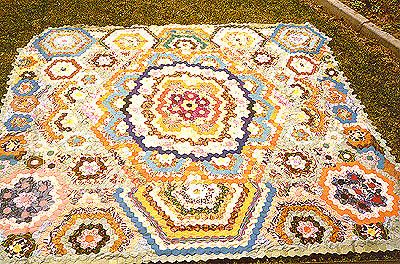Quilt No.1023JL - Joyce Lannin

The quilt was made by Joyce Lannin at Lake Grace, Western Australia in the 1960s. It is still owned by Joyce and is used at her home at Lake Grace.
Joyce Lydia Lannin. "As long as she can remember, Joyce has had an interest in sewing. As a small child she sat and watched her mother sewing at the machine or doing fancy work by hand so it is not surprising that she soon had a needle and cotton in her hands
When her mother began doing patchwork it was no wonder that Joyce took an interest in that too. From her mother she obtained her first hexagon template and was soon spending all her spare time sewing medallions together to make her first quilt. She worked the medallions in patterns as the ideas came into her head with the result that the quilt is very beautiful. At this time there were no books as it was before patchwork became popular.
After completing the first quilt Joyce decided to make a quilt for each of her four granddaughters. These quilts were made with large patches forming stars in the colours of their bedrooms. They are all different as the patches are arranged differently and thus each has its own appearance."
�������.."Joyce has only made her quilts from patches she has in her scrap box. They have all been made by hand and sewn by hand. The backs are all made from sheets with a row of patchwork flowers at the edge." [Joyce Lydia Lannin]
Related Quilts:
1370 x 1220mm
Hand sewn and hand quilted.
2236 x 1804mm
2100 x 1950mm
1740 x 1300 mm.
1780 x 1530mm
2236 x 1550mm






